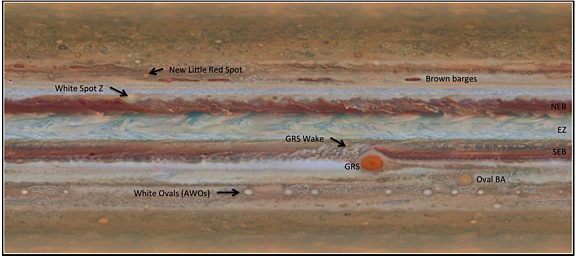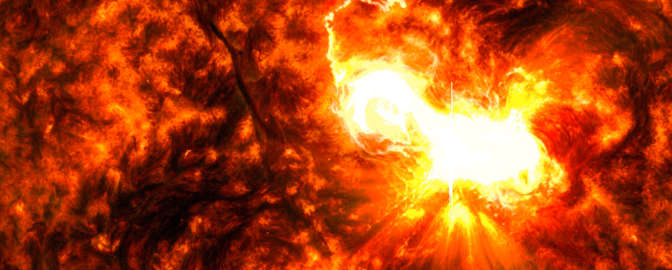Jupiter Weather Report: 2014/15 Apparition

Written by
Leigh Fletcher
Royal Society Research Fellow, University of Oxford
November 5, 2015
In an earlier post, I described how the army of citizen scientists provide near-continuous updates on Jupiter's atmospheric phenomena, allowing the British Astronomical Association and others to provide regular digests on jovian weather and reasonable forecasts of what might be coming. At the time of writing (September 2015) Jupiter is a few weeks past solar conjunction and ready to make it's reappearance in our dawn skies, so the 2014/15 apparition that was centred on the February 6th opposition (when Jupiter was at its biggest and brightest) is now over. Scientists all over the world are preparing observing proposals for the next 2015/16 apparition on Earth-based observatories, which will be the final opportunity to characterise Jupiter's churning weather before the arrival of the Juno spacecraft on July 4th 2016. For details of the nomenclature of Jupiter's belts and zones, please refer to my previous post.
From the amateur community, the first images of the apparition were uploaded to PVOL on August 31st 2014, and the last ones on July 31st 2015. I'm indebted to Marco Vedovato of the Italian Amateur Astronomers Planet Section for using the WinJUPOS software tool to create global maps of Jupiter regularly during the apparition - his index of maps can be found here. Further insights into Jupiter's complex goings-on have been provided by the wonderful Hubble Space Telescope's OPAL (Outer Planet Atmospheres Legacy) project, led by Amy Simon, Mike Wong and Glenn Orton. Hubble observations of Jupiter on January 19th 2015 are available here, and a new '4K movie' released by HST can be seen below.
Below I've provided links to some of Vedovato's JUPOS maps for various points during this apparition - they prefer having north to the bottom of the images as this is how Jupiter would really be seen through the eyepiece. The following four images were taken between October 2014 and April 2015, and you can see the evolution of features by toggling between them (all should be credited to Marco Vedovato and the JUPOS team).
South Tropical Domain: GRS Shrinkage has Slowed?
Jupiter's Great Red Spot, sat between the South Equatorial Belt (SEB) and South Tropical Zone (STropZ), has been steadily shrinking in east-west extent for many years (we've known this for a while, despite recent news reporting!). A couple of years ago the community discovered that this shrinkage had gone through an unprecedented acceleration, with measurements by citizen scientists suggesting a longitudinal width of 13.6±0.7 degrees in 2013/14, down from 15.3±0.8 degrees in 2011/12. In 2014/15 this longitudinal shrinkage seems to have stopped or slowed down, with the size being the same as last year - approximately 13.8±0.9 degrees longitude according to measurements by the JUPOS team (Vedovato et al. - see his charts here). M. Jacquesson was able to use November 2014 images to measure the internal rotation of the GRS at approximately 3.8 days, consistent with values measured in the 2013/14 apparition.
Observations from the Hubble Space Telescope (Simon et al., 2015) captured some wonderful spiralling filamentary structure within the GRS core, and indicated that the core of the GRS remains just as orangey-red as it did in the previous 2013/14 apparition, consistent with the general appearance in the amateur imaging. It has narrowed in latitudinal (north-south) extent too, implying a less severe interaction with the SEBs retrograde jet that flows around its northern periphery.
As for the rest of the South Equatorial Belt (SEB), it appears to be business as usual - lots of complex rifting in the turbulent wake to the northwest of the Great Red Spot, and no sign of any 'fading activity' such as that last witnessed in 2009/10, when the entire SEB whitened over. It's really hard to predict these SEB whitening cycles, so who knows when the next might begin!
North Tropical Domain: Waiting for an NEB Expansion
North Equatorial Belt (NEB): The width of this dark-red belt changes over time, having shrunk during 2013 with the disappearance of the dark, distinct brown barges on its northern edge. At the end of the 2014/15 apparition it may be on the verge of expanding again (the last such event took place in 2012), meaning that those brown barges could reappear during the next apparition. NEB broadening events have been occurring at 3-5 year intervals since 1988, so we might expect another in the next couple of years - observers will be waiting to see if such a dramatic change in the belt/zone structure happens next year. One of the most conspicuous features is 'White Spot Z', a white oval right on the ragged northern edge of the NEB (near 17N) that had a more reddish tinge last apparition. This white spot can also be seen in the Hubble imaging.
The Hubble images in January 2015 captured some fine-scale waves within the NEB near 16N, a type of structure known as a baroclinic wave, not seen in Jupiter imaging since the Voyager days. This fine wave was superimposed on top of other NEB cloud features, including a chain of cyclones at the same latitude and whiter anticyclones on the northern edge of the NEB (the retrograde jet called the NEBn).
North Temperate Domain: Brown Barges
The Northern Temperate Domain last underwent an upheaval back in 2012, and the cloud structures in this region still appear complex 3 years on. In particular, there are several cyclonic 'Brown Barges' on the North Temperate Belt (NTB) near 30N: 4-5 brown barges are now evident within the NTB and are extremely elongated in east-west extent. John Rogers suggests that rifting during the previous apparition generated an extremely dark spot in the Northern Temperate Zone (NTZ), which lengthened to become a dark streak that somehow evolved into the extremely long barge that we see today.
In general though, there were no signs of large NTB outbreaks (plumes on the jets), which occur at approximately 5-year intervals - the next one is likely to occur in 2016 or 2017, right smack bang in the middle of the Juno mission. The NTB might have been showing signs of fading, as it does just before an outbreak, but when Jupiter disappeared from view the NTB was still unchanged...
The amateur community caught the birth of a new Little Red Spot in December 2014, just to the north (32N) of the brown barges. It can be seen in the Hubble imaging, below. It started as a white spot interacting with other ovals (that didn't survive), becoming larger and fawn-coloured, before appearing brighter and redder in January 2015.

South Temperate Domain: Spots!
Oval BA continues its slow eastward traversal of the temperate region, with a slightly weaker red colour than the previous apparitions (could the chemistry responsible for its reddening somehow be weakening, or the materials aging?). BA passed the GRS again in the October 2014 (BA moving east, the GRS moving west), an event which happens every couple of years. This close passage generated lots of chaotic structure in the STropZ that's sandwiched between BA and the GRS, providing insights into how these two giant anticyclones interact with one another. Intriguingly, a faint bluish region currently exists in the South Temperate Belt (STB) known as the STB Ghost - this cyclonic structure interacts with any spots that impinge upon them, but its importance for the dynamics of the STB is still being explored. The structured segments of the South Temperate Domain were subject of a detailed report by Rogers et al. that can be found here.
Even further south, the South South Temperature Belt (SSTB) is home to lots of anticyclonic white ovals (AWOs) - they can be clearly seen in the amateur imaging against the darker background, with more than ten of them moving towards the east over time.
Summary
The 2014/15 apparition was largely business as usual for Jupiter, with the birth and death of new small red spots; chaotic activity in the equatorial belts and numerous white ovals in the south. The GRS shrinkage may have slowed for now, and the brown barges in the North Temperate Domain are longer than we've seen in a long time, but the really exciting changes might still be to come in the next apparition. In his three-year forecast for Jupiter, John Rogers suggests that we're waiting for both an outbreak of plumes on the North Temperate Belt jetstream and an expansion event for the North Equatorial Belt for the first time since 2012 - who knows what we'll find when Jupiter reappears for the first 'Juno apparition' of 2015/16.
Earth's First Line of Defense
Support the team of astronomers defending Earth with a gift today.
Donate

 Explore Worlds
Explore Worlds Find Life
Find Life Defend Earth
Defend Earth


